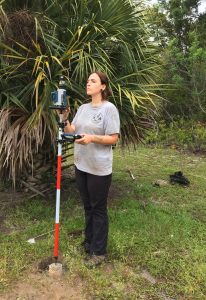
From the November 2017 Desktop News | If there’s anything anthropology graduate student Cayla Colclasure has discovered in her research, it’s that studying those who have gone before us is an important part of moving forward. Alongside her mentor, Dr. Elliot Blair, Colclasure is doing just that in a revolutionary way on Creighton Island, a privately-owned island in McIntosh County, Georgia. The pair is utilizing an upgraded piece of equipment to gather information from Creighton about indigenous communities from the Mississippian period that predate the arrival of the Spanish in the area.
Creighton Island allows for excellent data collection because it is largely uninhabited and undeveloped, making it ripe for anthropologic research. “The island has been owned by a single family since the 1940s and because of this has been largely undeveloped, resulting in a spectacular place to study a 5,000-year history of human occupation along the Atlantic coast,” Blair said. “5,000 years ago is about when sea level stabilized and estuarine resources would have first been available to the residents of Creighton Island. Prior to 5,000 years ago, Creighton Island wouldn’t have been a particularly appealing place to live.
“This past summer was the first field season of what we hope will be many more seasons of archaeological investigations,” he continued. “We began the project by examining the archaeological remains on the northern part of the island, where CB Moore—an important amateur archaeologist—excavated a large burial mound in 1897, recovering some of the most spectacular Late Mississippian artifacts ever recovered from the Georgia coast. Additionally, limited surface collections conducted in the 1950s and again in the 1980s recovered small quantities of 17th-century Spanish colonial artifacts at this site. Our own surveys this summer confirmed the 17th-century Spanish component and documented the very large and important Late Mississippian settlement that was suggested by Moore’s early investigations.”
Colclasure, whose work focuses on shellfish collection and consumption practices among the indigenous population on St. Catherine’s Island, a neighbor to Creighton, during the Spanish Mission-era (1565–1680 CE), said that an important aspect of their continuing research is the new data collector. “Normally when using a total station to record where features and artifacts are located on the landscape or plot out grids for geophysical survey as we were doing [on Creighton], you would need two people involved. The data collector essentially allows someone to operate the total station remotely,” Colclasure explained. “Only needing one person to run the total station meant that another set of hands were free to do geophysical survey, surface collection, and shovel test pits. We were able to get more work done thanks to the data collector.”
Colclasure will use the information discovered on Creighton to compare to that found on St. Catherine’s and hopes to form a more well-rounded story of how our ancestors lived. She plans to spend another month on St. Catherine’s and three weeks on Creighton in the upcoming year. She’ll graduate in 2019. “Working somewhere like Creighton Island, which is undeveloped and has had relatively little previous research conducted there, is a rare and wonderful opportunity,” she said. “There are many exciting possibilities as to what we might uncover there.”